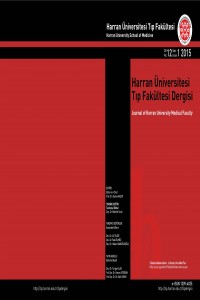Öz
Dear Editor,
Cervico-isthmic pregnancy is a rare complication of pregnancy. The incidence of cervical and cervicoisthmic pregnancy ranges from 1:2400 to 1:4500 (1, 2). Appropriate early diagnosis and treatment lead to the
remarkable reduction of maternal mortality from 45% to approximately zero (1). We describe the first case of
a cervico-isthmic pregnancy in the first trimester that was associated with a placenta percreta and was
managed surgically because of massive hemorrhage.
A36-year-old woman, gravida 6 para 3, who was referred from a state hospital because attempted dilatation
and curettage for 8 weeks gestation was complicated by massive vaginal bleeding. Her obstetric history was
notable for three previous cesarean sections and two spontaneous abortions, both followed by curettage. She
was in moderate general condition. There was marked pallor, blood pressure 90/60 mmHg and pulse
120/min. The patient's hemoglobin level was 6.0 g/dl.
Pelvic examination in our center revealed that the patient's vagina was filled with a blood clot. After
evacuating the vagina, severe bleeding through the cervical os was observed. The uterus was enlarged and
approximately 8-9 weeks gestation. An ultrasound examination showed a cervical pregnancy with a dead
fetus of 8 weeks gestation. An emergency laparotomy was performed. This pregnancy was associated with a
placenta percreta that was located on the anterior wall of the servico-isthmic region, just under the posterior
wall of the bladder. Bladder dissection revealed neovascularization on the anterior wall of the servix. Due to
above findings, a total abdominal hysterectomy was performed with conservation of both ovaries (Fig. 1).
Altogether, she was transfused with five units of blood. The postoperative course was uneventful. She was
discharged 4 days later in a general good condition. The pathologist confirmed the diagnosis of cervicoisthmic placenta percreta.
Although the cause of cervical and cervico-isthmic pregnancy is unclear, previous cesarean deliveries,
previous curettage, Asherman's syndrome, previous cervical or uterine surgery are the likely contributing
factors (1, 2). The above factors certainly contributed to development of the anormal placentation (3).
Early diagnosis of cervico-isthmic pregnancy is very important due to high morbidity and mortality rates.
When evaluating patients with first trimester bleeding who have predisposing factors for cervico-isthmic
pregnancy, high clinical suspicion should lead to prompt imaging studies to avoid the potential catastrophic
outcome associated with cervico-isthmic pregnancy.
Anahtar Kelimeler
Kaynakça
- 1. Parente JT, Ou C-S, Levy J, Legatt E. Cervical pregnancy analysis: A review and report of five cases. Obstet Gynecol 1983;62(1):79-82. 2. Hoffman HM, Urdl W, Hofler H, Honigl W, Tamussino K. Cervical pregnancy: a case reports and current concepts in diagnosis and treatment. Arch Gynecol Obstet 1987;241(1):63-9. 3. Weckstein LN, Masserman JS, Garite TJ. Placenta acreata: a problem of increasing clinical significance. Obstet Gynecol 1987;69(3 Pt 2):480-2.
Öz
Dear Editor,
Cervico-isthmic pregnancy is a rare complication of pregnancy. The incidence of cervical and cervicoisthmic pregnancy ranges from 1:2400 to 1:4500 (1, 2). Appropriate early diagnosis and treatment lead to the
remarkable reduction of maternal mortality from 45% to approximately zero (1). We describe the first case of
a cervico-isthmic pregnancy in the first trimester that was associated with a placenta percreta and was
managed surgically because of massive hemorrhage.
A36-year-old woman, gravida 6 para 3, who was referred from a state hospital because attempted dilatation
and curettage for 8 weeks gestation was complicated by massive vaginal bleeding. Her obstetric history was
notable for three previous cesarean sections and two spontaneous abortions, both followed by curettage. She
was in moderate general condition. There was marked pallor, blood pressure 90/60 mmHg and pulse
120/min. The patient's hemoglobin level was 6.0 g/dl.
Pelvic examination in our center revealed that the patient's vagina was filled with a blood clot. After
evacuating the vagina, severe bleeding through the cervical os was observed. The uterus was enlarged and
approximately 8-9 weeks gestation. An ultrasound examination showed a cervical pregnancy with a dead
fetus of 8 weeks gestation. An emergency laparotomy was performed. This pregnancy was associated with a
placenta percreta that was located on the anterior wall of the servico-isthmic region, just under the posterior
wall of the bladder. Bladder dissection revealed neovascularization on the anterior wall of the servix. Due to
above findings, a total abdominal hysterectomy was performed with conservation of both ovaries (Fig. 1).
Altogether, she was transfused with five units of blood. The postoperative course was uneventful. She was
discharged 4 days later in a general good condition. The pathologist confirmed the diagnosis of cervicoisthmic placenta percreta.
Although the cause of cervical and cervico-isthmic pregnancy is unclear, previous cesarean deliveries,
previous curettage, Asherman's syndrome, previous cervical or uterine surgery are the likely contributing
factors (1, 2). The above factors certainly contributed to development of the anormal placentation (3).
Early diagnosis of cervico-isthmic pregnancy is very important due to high morbidity and mortality rates.
When evaluating patients with first trimester bleeding who have predisposing factors for cervico-isthmic
pregnancy, high clinical suspicion should lead to prompt imaging studies to avoid the potential catastrophic
outcome associated with cervico-isthmic pregnancy.
Anahtar Kelimeler
Kaynakça
- 1. Parente JT, Ou C-S, Levy J, Legatt E. Cervical pregnancy analysis: A review and report of five cases. Obstet Gynecol 1983;62(1):79-82. 2. Hoffman HM, Urdl W, Hofler H, Honigl W, Tamussino K. Cervical pregnancy: a case reports and current concepts in diagnosis and treatment. Arch Gynecol Obstet 1987;241(1):63-9. 3. Weckstein LN, Masserman JS, Garite TJ. Placenta acreata: a problem of increasing clinical significance. Obstet Gynecol 1987;69(3 Pt 2):480-2.
Ayrıntılar
| Birincil Dil | İngilizce |
|---|---|
| Bölüm | Editöre Mektup |
| Yazarlar | |
| Yayımlanma Tarihi | 15 Nisan 2015 |
| Gönderilme Tarihi | 3 Ocak 2014 |
| Kabul Tarihi | 5 Ocak 2014 |
| Yayımlandığı Sayı | Yıl 2015 Cilt: 12 Sayı: 1 |
Harran Üniversitesi Tıp Fakültesi Dergisi / Journal of Harran University Medical Faculty


